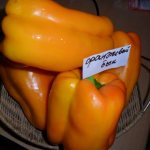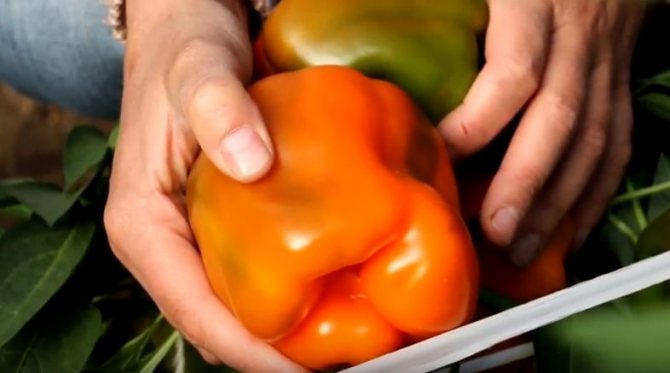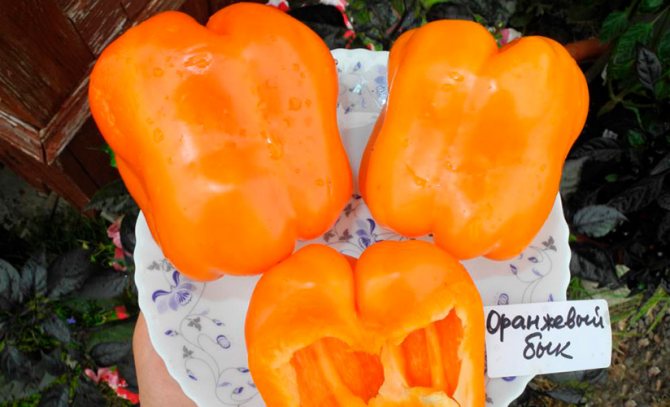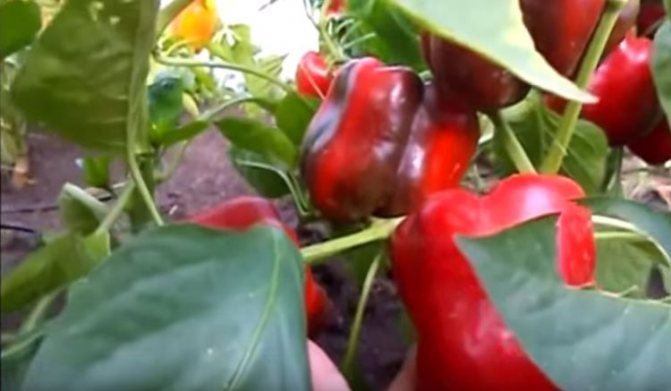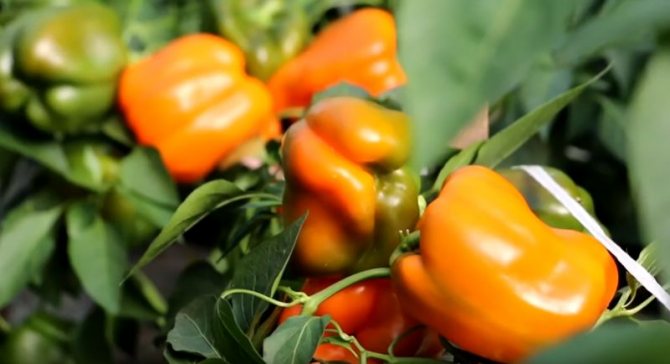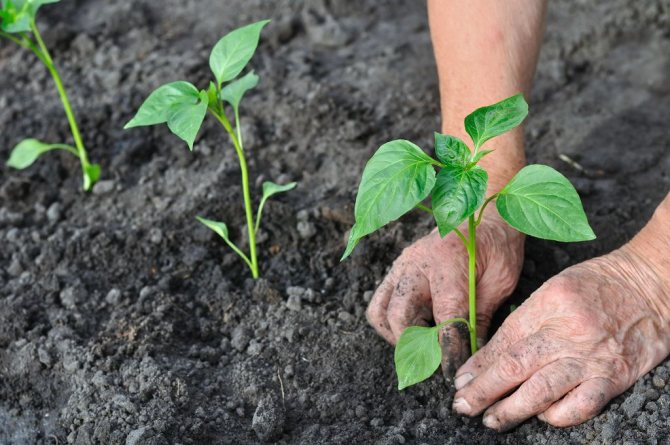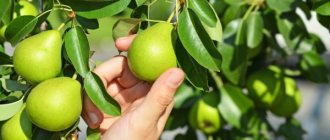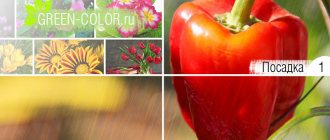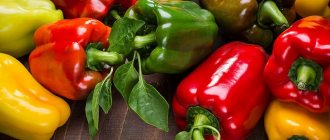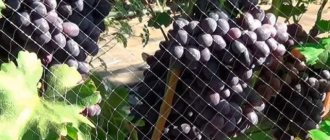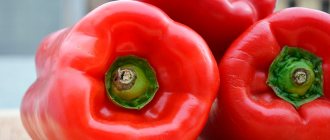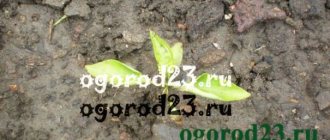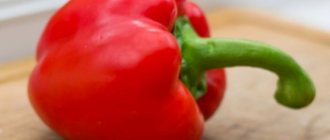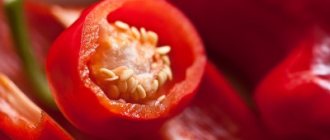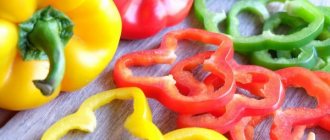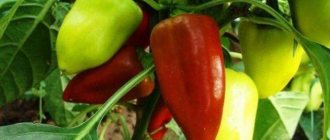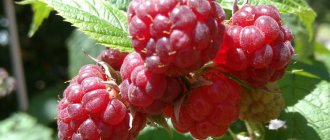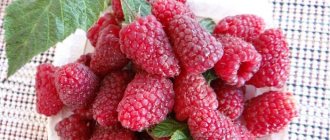Your personal gardening consultant!
When there is a desire to grow not just peppers, but surprising with special characteristics, then varieties with large fruits or with an interesting shape, in general, something unusual and original, are often chosen. One of these varieties is the large-fruited high-yielding pepper Red Bull, produced by agro in the “Russian Bogatyr” series. The variety is quite new, but has already gained popularity among summer residents and vegetable growers.
Description from breeders: • The variety belongs to the early: 95 days - the period from emergence to first fruiting. • Versatile cultivation: greenhouses, shelters or open beds. • A powerful bush grows up to 150 cm high. • Fruits are red, have a pulp thickness of 0.6 to 0.8 cm; the shape is cuboid, slightly elongated. The diameter of the peppercorn is about 9 cm, and in length it can grow up to 20 cm. • Average weight of pepper 200 - 250 g. • The variety is resistant to diseases. • The purpose is universal: fresh consumption, blanks, conservation. • Seed germination rate of 92%.
Pepper Red Bull: reviews, cultivation features and advice
Like many other varieties, the Red Bull is grown in seedlings. Sowing seeds for seedlings begins in the first days or in the middle of March - for subsequent planting in open beds; for greenhouse cultivation, you can start in January or February. Before planting, given 92% germination, the seeds can be soaked for twenty minutes in a weak solution of potassium permanganate, and then, if available, in aloe juice. This procedure disinfects and adds strength to the seeds.
Red Bull pepper is sensitive to the level of acidity of the soil, as well as to the content of salts in it, therefore it is recommended to add additional lime or dolomite flour: for 1 kg of soil 20 g. Seedlings are grown in the traditional way. If the sowing was not carried out in separate pots at once, then a dive is necessary, in which the roots of the sprouts can be treated with a growth stimulator so that they better take root and develop. Of course, do not forget about hardening the seedlings in order to increase the stress resistance of plants and their resistance to weather "surprises" in the form of sudden cold snaps.
They are planted in a permanent place in a greenhouse or open ground in May, in regions with a colder climate - in early June. Experienced vegetable growers advise planting peppers in places where other nightshades have not grown for two to three years: tomatoes, potatoes or blue ones. After planting, lateral shoots and leaves are removed from the bushes until the first branching of the stem. For this variety, it is necessary to provide for tying supports, since the bush grows quite tall with relatively heavy fruits.
Pepper Red Bull, as a large-fruited variety, needs proper feeding and the regularity of this event. Only with such care can you get especially large fruits. During the growing season and fruiting, fertilizers are applied to the ground three times, about a liter of solution is used for each pepper bush: the 1st fertilizer is carried out two weeks after planting the seedlings in the soil: 2 teaspoons of superphosphate are dissolved in a bucket of water (10 liters).The 2nd fertilizer is applied during the formation of flowers: 4 teaspoons of superphosphate and 1 spoon of carbamide and potassium sulfate are taken in a bucket of water. The third feeding is carried out during the ripening of the fruits: for the same volume of water, 2 teaspoons of potassium salt and superphosphate are used. With such a feeding scheme, the weight of the Red Bull fruit can reach 350 or even 400 g, and the peppercorn can grow up to 20 cm in length.
Reviews of the variety are very good, especially disease resistance. It is noted that fewer peppers are tied on the bush than in other early varieties, but the Red Bull wins in terms of the total weight of the crop, besides, the fruits can be picked still green - they ripen very well. Also, many growers believe that this variety is more of a medium ripening than an early one.
Peppers Yellow Ox and Orange Ox: reviews of summer residents
In addition to the red-fruited variety, this series also includes peppers with orange and yellow fruits: Orange Bull and Yellow Bull. The Orange Bull pepper reviews are characterized as a well complementary variety for the preparation of multi-colored preservation, because the size and shape of these peppers is the same. Growing seedlings, caring for them, fertilizing the Yellow Bull and the Orange Bull are completely similar to the variety with the red color of the fruit.
Vegetable growers, both professionals and amateurs, respond positively to all varieties of this line, high juiciness of peppers, deliciousness and, of course, their size are noted. Unpretentiousness and a long fruiting period are noticed. Many people think that these peppers keep well.
Read also: Black currant, Variety Exotic - FGBNU VNIISPK
The only drawback may be that it seems that it does not bear fruit well in all regions. Unfortunately, these varieties are not the best for areas with cool and short summers: the bush grows strong and healthy, but the fruits are tied in small quantities and do not have time to ripen to technical ripeness. This applies to growing in open beds, but in greenhouses, a good result is obtained.
A series of varieties Red Bull, Orange Bull and Yellow Bull provides summer residents with a wide field for experimentation and will certainly delight in the middle of summer with excellent results in the form of large and tasty "goby peppers".
Share useful information:
Experts on the features of agricultural technology
It is necessary to prepare seedlings in March. This is done according to the proposed schedule. You can dive a sprout if you have at least one real leaf. When planting in the soil, immediately place a support next to the plant.
Attention! Without active formation, the bush will be taller and produce smaller fruits. But its overall yield will remain the same.
Sowing seeds for seedlings | Planting seedlings in a greenhouse / greenhouse | Planting seedlings in OG | Stepping | Harvesting (in the greenhouse / in the exhaust gas) |
| March | May | The beginning of June | In the exhaust gas, cut off the processes to the lower fork of the stem, in the greenhouse - form a bush of 3-4 stems | Mid-July / end-July |
| * terms are indicated for central Russia | ||||
What are Bulls
There are several types of this variety on sale: Red Bull, Orange Bull, Yellow Bull. These are common and not quite common varieties.
The fruits are large, with their inherent taste, thick-walled, juicy. The unusual thing is that the fruits are set even in a dimly lit place, under conditions of growing in a greenhouse.
It is possible to remove them at the stage of technical ripeness, and then they ripen perfectly in the torn form to varietal color.
You can read about what varieties of thick-walled peppers can be grown in the open field here.
All of these peppers are grown using the conventional seedling method.
Red Bull
A variety of medium ripening. The fruit is large (up to 200 g), long (up to 20 cm), elongated, with 3-4 lobes.
The walls are thick, the taste is sweet with a specific taste of bell pepper. When technically mature it is green.When removed, it turns red within 4-5 days.
According to the reviews of many gardeners, this species is distinguished by 100% seed germination. The Red Bull pepper variety is excellent for growing in a polycarbonate greenhouse.
In the southern regions of Russia, subject to all the rules of agricultural technology, it can grow in an open garden. The bush reaches a height of one and a half meters.
Resistant to diseases of tobacco mosaic and others affecting nightshades, in particular, potato viruses.
Useful qualities
Pepper "red bull" contains carotene and almost all vitamins from group B. Its fruits also contain essential oils, useful sugars and nitrogenous substances. Scientists also managed to find potassium with sodium, calcium, phosphorus, iron, sulfur and silicon in juicy vegetables. Vitamin C and beta-carotene in the red bull are believed to help prevent the formation of cancer cells. Moreover, this vegetable heals ulcers. Such a rich list of nutrients, combined with an excellent taste, has become the reason that many people strive to grow exactly the "red bull" pepper on their plots.
Orange Bull
Hybrid variety. Designed for greenhouses, grown in the southern regions of Russia in an open garden.
Mid-early ripening of the variety. The semi-spreading form of the bush reaches one meter in height. The fruits are large enough.
Usually weighing about 200 g, with excellent agricultural technology, they can reach 300-400 g. Peppers have an interesting cuboid shape. The walls are thick and juicy, about 1 cm thick.
In the phase of technical ripeness they are green, when ripe they become orange in color. According to the reviews of summer residents, they can acquire a bright yellow color, close to orange. Nice taste. Up to 12 kg of fruit can be harvested from 1 square meter.
You can read about what varieties of bell peppers can be grown in the open field here.
You may also find useful an article on the benefits and dangers of bell pepper.
It is worth noting that the abundance of fruits can damage the bush, so harvesting must be done regularly. When transplanting seedlings, a prerequisite is the installation of a peg for tying a growing and fruiting bush.
Grows well in a greenhouse or under a film cover. The seedlings are grown in the usual way. Pepper can be used both in summer salads and in preparations.
Description of the variety, reviews, photos
Mid-season, thick-walled, large-fruited sweet pepper variety for greenhouses and open ground. The period from germination to the beginning of ripening is 100-110 days.
The bush is semi-spreading, 80-110 cm high. A garter to the support is desirable. The leaf of this variety is medium-sized, green, wrinkled.
How to form an Orange Bull pepper, see the video below.
Fruit characteristics
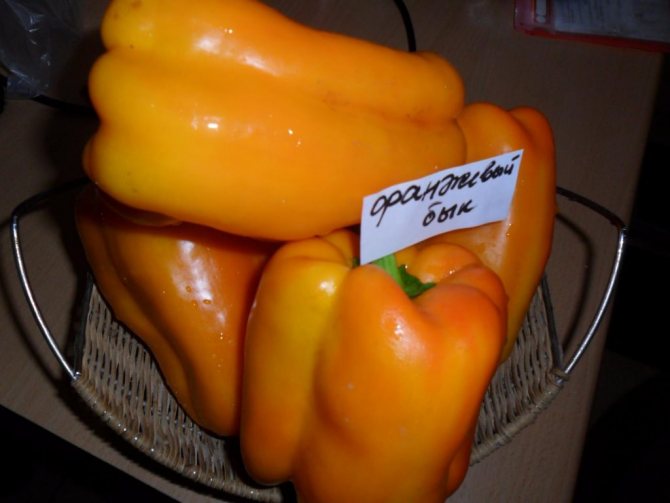
Fruits are large, cuboid, bright orange at full maturity, weighing 200-250 grams (up to 400 grams), juicy, very tasty, without bitterness. The thickness of the fruit wall is up to 1 cm. These peppers are suitable for fresh consumption, cooking lecho, canning, home cooking.
Yield: 7-14 kg of fruits per 1 sq. meter of planting (depending on growing conditions).
The variety is resistant to the tobacco mosaic virus.
Sweet pepper Orange Bull is included in the State Register of the Russian Federation.
Yellow Bull
Another type of variety with an average ripening period. Large and beautiful fruits reaching 200-300 g by weight.
Spreading bush, medium-sized. The name of the species of this variety speaks for itself. Fruits are yellow in color when fully ripe.
You can shoot at technical ripening, when they gain the required mass of the fruit, but will be green. Fruits can be set before the onset of cold weather.
They are distinguished by good preservation, can be used in salads, frozen or when preparing for the winter. Every year, all new varieties of pepper appear on sale, so you need to keep track of new products.
How to choose pepper seeds for your site, see expert advice and an overview of pepper varieties in the following video:
Pepper "Yellow Bull F1": a variety with many strengths
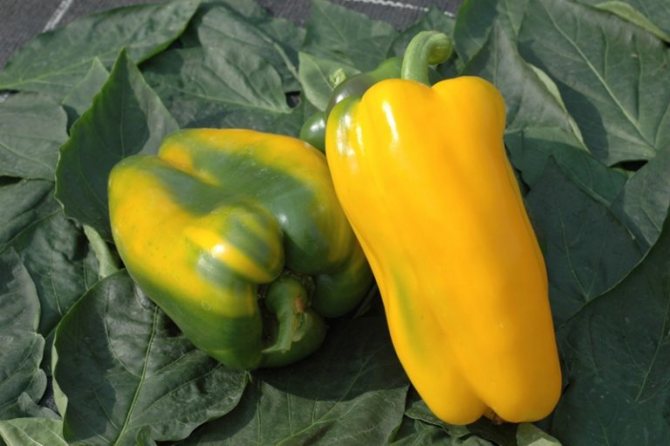

Vegetables are very beneficial to our health, which should not be underestimated. They not only contain a lot of vitamins, macro- and microelements, but also fiber, which serves as an assistant to our digestion. Not all vegetables can be eaten with the same pleasure by people fresh and processed, but peppers are ideal for this. Everyone can get his harvest in his area, and knowing a good variety, it is also very high. We advise you to get acquainted with the Yellow Bull F1 pepper, its characteristics and description of the variety. The hybrid has the best reviews, excellent yield, but in the photo you can see the sunny color of the fruits.
Read also: Basil - the benefits and harms for the body of women and men, medicinal properties and the use of herbs
Along with this article, they usually read:
Pepper Orange miracle: description, reviews, similar varieties of orange pepper. This Dutch variety of sweet bell peppers has been pleasing gardeners with good harvests for several years. The seeds of the Orange Miracle can be found on store shelves from several agricultural firms, which confirms the quality of the variety. However, it is not alone among the orange peppers. Sweet pepper Denis F1: description, characteristics of the variety, reviews. Pepper Denis has a prefix to the name "F1", which means it is a hybrid variety. This makes it suitable for growing in the open field, not just in closed greenhouses and greenhouses. "The Gardener and the Ogorodnik" will tell about the distinctive qualities and peculiarities of growing this sweet pepper. The best varieties of peppers for 2020: new good varieties at the end of 2020. "Gardener and Ogorodnik" has prepared a rating of the best varieties of peppers according to reviews of vegetable growers for 2020. In addition, you will find promising new varieties from several different agricultural firms that have proven themselves well.
general information
"Yellow Bull" has a pronounced name - this is not surprising. Often, breeders, having received a particular variety, give it a name that can somehow characterize the vegetable. The Yellow Bull was no exception. This is one of the leaders.
It is a hybrid pepper, as you can tell from the label in the name. First generation hybrids have long won the respect of summer residents, and the information that such fruits do not have good taste has long been a thing of the past.
This pepper, if you plant it, will be a confirmation of this. The hybrid was bred by Russian breeders by crossing two good predecessors. As a result, we got peppers with high performance in various parameters.
At first, it was grown only in the south and in the middle zone of the country, because the creators said so. But many summer residents in colder regions have experimented and obtained excellent results. Of course, when using greenhouses.
Characteristics and description
Description of the bush
- before the fork as it grows, you should always remove the leaves;
- a garter is required;
- it is customary to remove the first bud;
- bushes should receive a lot of light;
- the root system is strong, but many branches are close to the surface, so care must be taken when loosening.
The vegetables of this hybrid are a whole pride for breeders and summer residents. Sweet pepper "Yellow bull F1" has very large fruits, beautiful sunny yellow color. Their weight and dimensions are striking. In length, the fruits can reach up to 20 cm, in cross-section - up to 9-10 cm. Inside there are four pronounced chambers. There are few seeds.
The thickness of the skin is 9-10 mm, which is very convenient for housewives who make different culinary masterpieces. But more on that later. It is worth noting that, according to gardeners, the hybrid is very tasty, tender, sweet. The skin is dense, but not hard. Fruit weight on average is 200-250 grams. But summer residents say that with good care you can get peppers and 400 grams each. At the same time, the yield can vary in the greenhouse and in the south - 13-15 kg, in a temperate climate - 7-9 kg.
Maturation
Bell peppers "Yellow Bull" have medium or medium early ripening periods. It all depends on the place of planting - in warm regions, the harvest is always earlier, that is, the terms are medium early. Other places are closer to the average. The conditions in a given year in a particular area, soil fertility, and care also affect.
Description of the variety of large-fruited culture
The copyright for the Orange Bull bell pepper belongs to the agricultural company Gavrish. This fact was certified by the State Variety Commission in the selection register in 2012. The variety is approved for planting throughout the country. The place of cultivation is a temporary greenhouse or an open bed on the site.
Attention! The seeds belong to the Russian Bogatyr series. The manufacturer's catalog also contains Red Bull pepper with similar characteristics.
16 excellent varieties of plums for the Moscow region
The fruits of this variety are large, slightly elongated cubes. Some specimens from a greenhouse crop reach 20 cm and a weight of 400 g (with proper shaping of the bush). On average, the peppers are smaller, but the plant's yield is still at a high level. The fruits consist of 3-4 nests. They have thick walls. The largest ones - up to 1 cm, on average - 6-8 mm.
The peppers are wilted. In technical ripeness, they are green. Later, the color turns bright orange (as in the photo). The "bovine" bush has a strong main stem. It actively branches during the growing season. Medium leaf.
| Growth type, bush height | Half-stem, 0.8-1.1 m |
| Ripe fruit color | Orange |
| Landing scheme | 40x60 cm |
| Weight, length and shape of the fetus | About 250 g, 10-15 cm, cuboid |
| Ripening period, yield | Early ripe (100-110 days). In the greenhouse - up to 10-14 kg / m 2. In exhaust gas - about 7-10 kg / m 2 |
| Drop off location | Exhaust gas / greenhouse / greenhouse |
| Diseases | Possesses resistance to TMV |
| By type of use | Universal |
| Flowering type | No data available |
Disease and pest resistance
If you look at the packages of seeds from different manufacturers, you can see that the words "Not sick" are flaunting on them. The experience of summer residents has proven this. In this regard, the pepper is highly resistant, but things are different with pests. The hybrid can be harmed by aphids, thrips, Colorado potato beetle, whitefly.
Most often, gardeners try to fight them right away and use various folk methods - sprinkle the area with ash and tobacco dust, spray it with infusion on laundry soap or onions, garlic arrows. The nearby herbs and aromatic spices are also helpful. If the colonies have strongly infected the area, then insecticides are used - "Aktara", "Confidor". But these drugs are used strictly before flowering, so as not to get poisoned while eating.
Advantages and disadvantages
It is very pleasant to talk about the strong qualities of the yellow bull sweet pepper, because there are so many of them. And the cons are insignificant.
- high yield and productivity;
- resistance to ailments;
- weight of fruits and their sizes;
- yellow skin - and such vegetables are always more useful and do not cause allergic reactions;
- good keeping quality and transportability.
As you can see, there are a lot of advantages, and if we talk about the last point, it makes it possible to grow Yellow Bull pepper for sale.
- the possibility of insect wrecking;
- hybrid types of vegetables do not give a good harvest for next year, there is no point in collecting their seeds.
Care
Sweet peppers fortunately respond to feeding with organic fertilizers. Regular watering is also important. Mentor bushes are watered under the root or in furrows, holes. In no case is it forbidden to allow the topsoil to dry out.
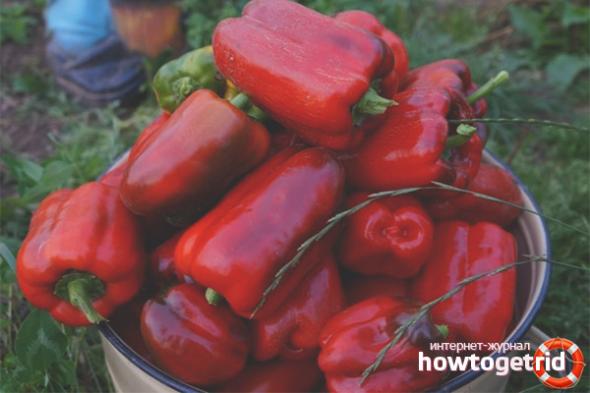

A well-warmed place without wind, on which there really is no shade, is suitable for growing peppers.
The retention of moisture in the soil is facilitated by the mulching procedure. Straw, grass cuttings, fodder or sawdust are used as mulch.In the soil under the mulch layer, earthen hearts, beneficial insects are actively developing, the soil is saturated with air. After watering, the soil should be loosened, giving oxygen to the roots.
Pepper, grown with the use of mulching, loosening the soil, gives a persistent high yield, while larger fruits ripen.
Heat above +35 degrees is detrimental to bell pepper pollen, sympathy simply becomes sterile, the flowers stop pollinating and the ovary does not form.
There are no words, the time of flowering and the formation of the ovary is not recommended to use a large amount of chemicals, it is better to feed the pepper with folk remedies. Use the milk hole with iodine: 1 liter of skim milk, 20 drops of iodine alcohol tincture in a bucket of water.
During the flowering period, be sure to remove stepchildren so that nutrients are not taken from the bush. Spray plants with biostimulant zircon in order to obtain a bountiful harvest.
Grassing is an important technique that allows you to multiply the yield of pepper. If the stepchildren are not removed, then the plant's forces will go from above to form a green mass, and not fruits.
Features of growing varieties
Growing seedlings
Sowing begins at the end of February and continues until March. Each summer resident is guided by his own climate - by the time the seedlings are planted, the soil should warm up by 14-15 degrees, all threats of frost should be bypassed. Most often, in the middle lane, they are transferred in late May and early June, in the south - in mid-May, in the north - by the second decade of June in a greenhouse. Remember that the Yellow Bull sweet pepper hybrid is very thermophilic.
Read also: How to remove weeds from an overgrown area
Early planting includes lamps to extend daylight hours, which are lacking in February and March. The most commonly used daylight. There is no need to pickle the seeds, but the soil from pests is always spilled with boiling water with manganese. Then they are dried, laid out in peat pots. We always recommend them, since pepper is a culture with a delicate root system that does not tolerate picking well. As for the composition, it can be a universal soil for nightshades or a mixture of turf soil, humus and sand in equal parts.
The seeds are buried 1 cm, sprayed to moisturize and cover all the pots with foil, for convenience they are placed in a common tray. Then they are placed in a warm room, where the temperature is not lower than 23-25 degrees. After 4-9 days, you will already see the shoots. Remove the film and put it on a sunny window.
Water the seedlings only as the soil dries out in order to exclude root rot. The pots absorb moisture very quickly, so you need to make sure that the soil does not start to lag behind the walls. Lamps are placed 50 cm above the seedlings so that the total daylight hours are about 10-12 hours. Once you can add nitrogen fertilization - urea or Kemira preparation. Two weeks before the transfer, the seedlings begin to harden - they are taken out to the balcony or open the window first for 30-60 minutes, then they are increased to half a day.
Transfer to the ground
You can start preparing the plot when you start hardening the seedlings. First, weeds are removed from it, then humus is introduced, with acidic soil, dolomite flour, and ash from parasites. All this is scattered over the site and dug up, along with the removal of weed roots. Before planting, spill boiling water with manganese in 2-3 days. After that, holes are made at a distance of at least 50 cm from each other. A support in the form of a stick is installed to each hole, unless you made a trellis. Then the landing goes along it.
A spoonful of complex feed with an abundance of phosphorus and potassium is added to each well. Everything is spilled with abundant warm water, pots are placed along with seedlings. After which the hole is buried, compacted next to the trunk.
Experienced summer residents note that it is not worth feeding the Yellow Bull pepper. Otherwise, there will be very large bushes, and there will be no ovary.Three times a season is enough. The first feeding - after two weeks from the moment of transfer - 1/10 mullein with water. Further, after 2-3 weeks, a complex mineral feeding.
Since fruitful and large-fruited varieties and hybrids always require a lot of moisture, watering should be regular. But here it is important not to overfill the area, but only as it dries. Then loosen the next day, and the water should be infused for 24 hours. But if you cannot water the bushes often, then simply lay a layer of mulch from straw. It retains both moisture and heat. Of course, even a beginner knows about weeds, which should not be in the beds.
As the bushes grow, they are neatly tied along the support. The crop is usually harvested in 110-120 days. In the greenhouse before, but do not forget that it must always be opened and ventilated. We have already mentioned above that some of the leaves need to be removed, the first bud too. Also, experienced summer residents are advised to pinch the growth point, thin out unnecessary twigs with leaves. In order for the pepper to set better, you can apply the preparation "Ovary" for spraying. To prevent insect attacks, use a soap solution, manganese, infusion on tansy, wormwood for spraying.
Seedlings
You can get the maximum yield if the established agrotechnical growing conditions are observed. It is best to sow F1 Red Bull pepper seeds for seedlings in March.
Disinfection of seeds in potassium permanganate helps to prevent possible bacterial and viral infections. Make a 2% solution and soak the seeds for 20 minutes. After disinfection, they are rinsed with cold water.
You can ensure 100% germination if you first germinate the seeds. To do this, they are placed in a damp cloth or gauze for 3-5 days and wrapped in polyethylene to retain moisture. The optimum temperature for germination is considered to be 24-270C.
Seeds are sown in nutritious loose soil. You can do it yourself by mixing ordinary garden soil with sawdust, humus and peat. But sawdust should be pretreated with urea. You can buy soil suitable for growing seeds at the store.
After the emergence of seedlings, the temperature is lowered to 200C for 2-3 days. Then it is raised again to 22-250C. With the help of artificial intense light, it is necessary to provide 12-hour daylight hours for seedlings. After a specified period of time, the seedlings are covered with a light-impermeable material. Excessive illumination leads to stretching of seedlings and a decrease in yield.
A warning! The soil is watered as it dries. Waterlogging and drying out of the earth should not be allowed, this has a bad effect on the development of young plants.
For the full development of seedlings, additional feeding is required. Plants should be fertilized every 2 weeks. Nitrogen and potassium complexes are used. Agronomists recommend to spray plants with Epin solution every 10 days. It warns of possible problems due to low light. They also use a root formation stimulator potassium guamate: for irrigation, a solution is made of 25 ml of concentrate and 10 liters of water.
When growing seedlings of Red Bull pepper, seeds are advised to immediately sow in individual containers. The plant does not tolerate picking, because the root system of peppers is poorly restored. The absence of picking allows you to reduce the time for growing seedlings by 15 days.
Application of the "Yellow Bull"
Such hybrids have a very wide table application. The crispy skin and juicy flesh are ideal for fresh salads. The bright color of the fruit will add beauty to the winter twists. Thick walls make them ideal peppers for stuffing. Dishes can be perfectly stored in the freezer, which is very convenient.
Also, the fruits are dried, frozen, pickled. Many housewives even make juices and sauces. Bell peppers "Yellow Bull" are considered one of the best vegetables for working in the kitchen.Also, its use is very beneficial for the health of young children, who are so often allergic to all red fruits, pepper is also suitable for feeding nursing mothers, people in rehabilitation.
You have met a wonderful hybrid. As you can see, there are a lot of advantages, unpretentiousness in cultivation. These indicators increase the chances of pepper becoming a resident of the beds of many gardeners.

